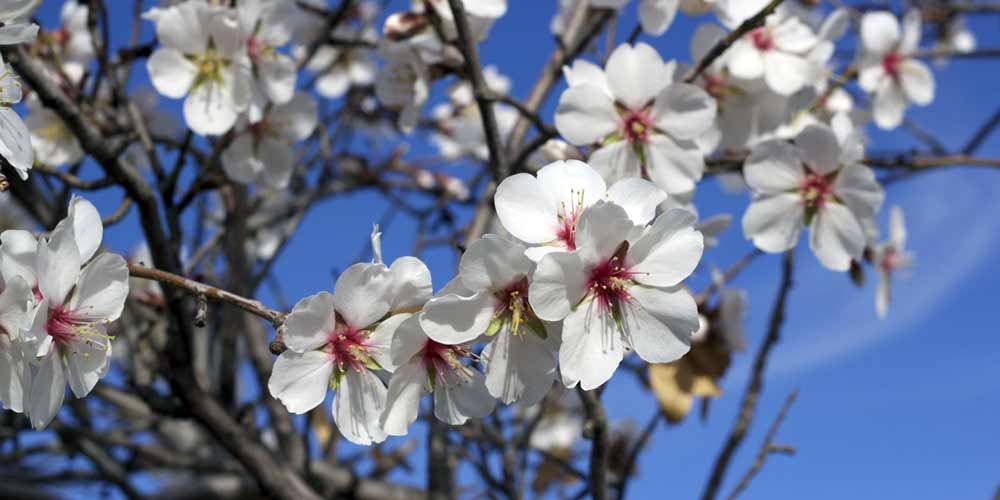By Dr. Thomas T. Yamashita
Almond hull rot is a damaging disease. The freshly opened hull is colonized by either a bread mold species (Rhizopus sp.) and/or the brown rot fungus (Monilinia fructicola). Both fungal organisms produce toxins which are easily translocated to the wood, killing the tissue and any branches reliant on those tissues. Severe infections can drastically reduce the fruiting area of the canopy.
Traditional methods of managing hull rot have a variety of negative impacts.
While the fungicide Iprodione is effective against both pathogens, it is restricted from use beyond 5 weeks past petal fall. Various other fungicides may have activity against Monilinia fructicola, but Rhizopus spp. are not affected.
The common recommendation for managing hull rot is to exercise deficit irrigation and minimize nitrogen fertility. Most growers have observed slight reductions in hull rot by going this route. However, deficit irrigation and minimized nitrogen fertility have a negative impact on the following year’s bud wood. In addition, deficit irrigation allows plant-feeding mite populations to reach damaging proportions.

Adjustments to soil and foliar nutrition are critical in treating almond hull rot.
For the past many years, I have explored a management scheme that minimizes hull rot through selective adjustments in both soil and foliar nutrition. This bulletin summarizes the rationale and outlines the effective program which reduces infection and allows trees to develop bud wood for the next season.
Both fungal pathogens, Rhizopus spp. and Monilinia fructicola, prefer colonizing tissues that are undergoing senescence or are expired. Characteristic to senescing or dead tissues is the uncoupling of chemical bonds that hold the cell walls together. In its healthiest state, a plant’s cell walls are held together by calcium and boron. Senescence or death of tissues occurs rapidly if these calcium and boron linkages are minimal or lacking. Further, when calcium and boron are deficient in tissues, ethylene production escalates, inciting further senescence of tissues. This is one of the reasons as to why imbalanced nitrogen fertility promotes infections of hull rot. While the nitrogen-rich tissues may grow rapidly, they are formed without the full complement of cross-linkages with calcium and boron.
When hull split occurs under imbalanced fertility regimes, the tear in hull tissues will initiate further senescence reactions. This unravels tissue bonds and creates a desirable food base for pathogens.
However, when hull split occurs under a balanced fertility regime, calcium and boron cross-linkages prevent these rapid senescence reactions. Instead, the tissue bonds remain intact, allowing the exposed hull tissue to anneal or harden with drying.
Furthermore, when hull split occurs under a balanced fertility regime, a variety of resistance compounds will be translocated to the wound to ward off fungal colonization. Many of these resistance compounds are produced by the pentose phosphate pathway and are derivatives of various phenols. For example, lignification is a resistance response in trees in which lignin deposited near a wound to ward off infection. But if trees are imbalanced in their nutrition, the resistance response is delayed and infection can occur. While calcium and boron are important, balanced arrays of other elements remain an integral aspect of hosting resistance to pathogen colonization.
The soil and foliar treatments described below can significantly reduce losses associated with almond hull rot.
Note that during the treatment period, use only these programs to avoid conflict. Avoid substituting what might seem to be comparable materials, as the materials listed below are ideally suited for minimizing hull rot. Institution of these programs allows the grower to irrigate and avoid deficit moisture periods.
Soil Treatment Program for Almond Hull Rot
Two weeks before hull split occurs, treat the soil with the following mixture:
- Thiocal – 15 gallons per acre
- K-Mend – 10 gallons per acre
- CN-9 – 5 gallons per acre
- Water – 5 gallons per acre
Blend the ingredients under agitation. For drip systems and mini-sprinklers, inject over sufficient time to achieve even distribution. For solid set or flood, lay down a 6- to 10-inch wide band about 1.5 feet from the trunk. Use irrigation to incorporate into the soil, and repeat every 5 to 7 days throughout the period of hull split.
Foliar Treatment Program for Almond Hull Rot
When 2 to 5 percent of hulls have split, treat trees with the following mixture:
- Fusion 360 Foliar FG-31 – 3 gallons
- Fusion 360 Integrity Calcium – 1.5 gallons
- Fusion 360 Integrity Z-422 – 1 quart
- Fusion 360 Integrity FG-Micros – 1 pint
- Phosphite Express – 1 pint
- Thiolux – 7 pounds
- K-Nite – 3 pounds
- 10% Boron – 6 ounces
- Silicon Surfactant – 4 ounces
Fill a spray tank at least three-fourths full of water and start agitation before blending materials. Apply a fine mist to the canopy at a rate of approximately 25 to 50 GPA. Repeat this spray every 5 days during the period of hull split.




